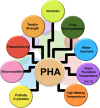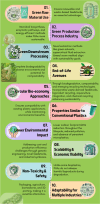PHA, the Greenest Plastic So Far: Advancing Microbial Synthesis, Recovery, and Sustainable Applications for Circularity
- PMID: 40787410
- PMCID: PMC12332672
- DOI: 10.1021/acsomega.5c00684
PHA, the Greenest Plastic So Far: Advancing Microbial Synthesis, Recovery, and Sustainable Applications for Circularity
Abstract
The global proliferation of nonbiodegradable petrochemical plastics presents severe environmental, health, and economic challenges, underscoring the urgent need for sustainable alternatives. Polyhydroxyalkanoates (PHAs), a family of biobased and biodegradable polyesters, offer a promising solution with their environmental compatibility, versatility, and ability to mimic conventional plastics. This review explores PHA production, encompassing microbial biosynthesis, metabolic pathways, and innovative extraction methods to optimize production and material properties. Genetic and metabolic engineering advances address cost and scalability barriers, and novel feedstock utilization. Innovations in copolymerization, blending, and nanocomposites have expanded PHA applications across packaging, agriculture, and biomedical fields. The evolution of smart and functionalized PHAs for high-value sectors such as regenerative medicine, drug delivery, and smart packaging further demonstrates their expanded potential beyond conventional bioplastics. Emphasis is placed on integrating PHAs into circular economy models by leveraging waste-derived feedstocks, emerging microbial strategies, including mixed microbial cultures (MMCs), halophilic systems, and aquaculture-integrated production, offer scalable and resilient routes for cost-effective, sustainable PHA biosynthesis. Despite their potential, PHAs remain hindered by challenges involving high production costs, inconsistent mechanical properties, and environmental trade-offs in downstream processing. PHAs are sustainable bioplastics that align competently with Green Chemistry principles, though improvements in energy efficiency and catalytic optimization are required for broader commercial applications. The review highlights novel recovery techniques aligned with a green bioeconomy, including green solvents, supercritical fluid extraction, enzymatic, mealworm, and other biorecovery methods. Integration with circular economy frameworks through waste valorization, biobased feedstocks, and zero-waste biorefinery models further enhances the sustainability of PHA production. Future research must optimize extraction methods, address microplastic risks, and expand into high-value markets. PHAs represent one of the most environmentally promising bioplastics to date due to their complete biodegradability, non-persistent microplastics, and lower emissions, with advancements in production further enhancing their viability. By advancing PHA technologies and fostering interdisciplinary collaboration, PHAs can accelerate the transition to a circular bioeconomy, offering a unique combination of full biodegradability, material tunability, and circular design that positions them as frontrunners in the transition away from fossil-based plastics.
© 2025 The Authors. Published by American Chemical Society.
Figures








Similar articles
-
The Opportunities and Challenges of Biobased Packaging Solutions.Polymers (Basel). 2025 Aug 14;17(16):2217. doi: 10.3390/polym17162217. Polymers (Basel). 2025. PMID: 40871164 Free PMC article. Review.
-
Prescription of Controlled Substances: Benefits and Risks.2025 Jul 6. In: StatPearls [Internet]. Treasure Island (FL): StatPearls Publishing; 2025 Jan–. 2025 Jul 6. In: StatPearls [Internet]. Treasure Island (FL): StatPearls Publishing; 2025 Jan–. PMID: 30726003 Free Books & Documents.
-
Scalable Step-by-Step Approach of Sustainable Bioplastic Production from Food Waste.J Vis Exp. 2025 Jul 18;(221). doi: 10.3791/68499. J Vis Exp. 2025. PMID: 40758639
-
Wood Waste Valorization and Classification Approaches: A systematic review.Open Res Eur. 2025 May 6;5:5. doi: 10.12688/openreseurope.18862.2. eCollection 2025. Open Res Eur. 2025. PMID: 40438563 Free PMC article.
-
Management of urinary stones by experts in stone disease (ESD 2025).Arch Ital Urol Androl. 2025 Jun 30;97(2):14085. doi: 10.4081/aiua.2025.14085. Epub 2025 Jun 30. Arch Ital Urol Androl. 2025. PMID: 40583613 Review.
References
-
- Friedel, R. D. Pioneer Plastic: The Making and Selling of Celluloid; University of Wisconsin Press, 1983.
-
- Puluhulawa F. U., Puluhulawa J., Puluhulawa M. R. U., Harun A. A.. Handling Plastic Waste Based on Sustainable Tourism in the Legal Framework of Telematics. WSEAS Trans. Environ. Dev. 2024;20:16–25. doi: 10.37394/232015.2024.20.3. - DOI
-
- Hadri S. H., Tareen N., Hassan A., Naseer M., Ali K., Javed H.. Alternatives to Conventional Plastics: Polyhydroxyalkanoates (PHA) from Microbial Sources and Recent Approaches – A Review. Process Saf. Environ. Prot. 2025;195:106809. doi: 10.1016/j.psep.2025.106809. - DOI
-
- dos Santos A. J., Oliveira Dalla Valentina L. V., Hidalgo Schulz A. A., Tomaz Duarte M. A.. From Obtaining to Degradation of PHB:Material Properties. Part I. Ing. Cienc. 2017;13(26):269–298. doi: 10.17230/ingciencia.13.26.10. - DOI
Publication types
LinkOut - more resources
Full Text Sources
